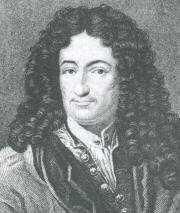@Electra phil,
Taking notes, excuse me please and feel free to say anything!
 Gottfried Wilhelm Leibnitz
Gottfried Wilhelm Leibnitz
Carrying on the Pythagorean-Platonic doctrine of universal harmony, Gottfried Wilhelm Leibnitz, who with Isaac Newton was the co-inventor of calculus, developed an elegant grand philosophy based on the concept of an evolving unit of consciousness called the monad. Monads for Leibnitz are the most fundamental metaphysical points which have always existed and can never be destroyed.
Leibnitz felt that all matter is alive and animated throughout with monads. The monad is the principle of continuity between the physical and the psychological realms. The same principle that expresses itself within our minds is active in inanimate matter, in plants, and in animals. Thus the nature of the monad is best understood by studying the spiritual and psychic forces within ourselves.
Monads themselves vary in the amount of consciousness or clarity of their perceptions. Certain physical facts, such as the principle of least action, indicated to Leibnitz an intelligence within the most basic particles in creation. On the other hand, the findings of psychology have indicated that there are areas of the mind that are unconscious in their nature. In the lowest monads everything is obscure and confused, resembling sleep. While in humanity, consciousness attains a state of apperception -- a reflexive knowledge of the self.
Every monad discovers its nature from within itself. It is not determined from without; there are no windows through which anything can enter; all of its experience already exists within each monad.
Both organisms and inorganic bodies are composed of monads, or centers of force, but the organism contains a central monad or "soul" which is the guiding principle of the other monads within its body. Inorganic bodies are not centralized in this way, but consist of a mere mass or aggregation of monads. The higher the organism, the more well-ordered will be its system of monads.
Every monad has the power to represent the entire universe within itself. It is a world in miniature, a microcosm, a "living mirror of the universe." Yet each monad has its own unique point of view, with its own characteristic degree of clarity. The higher the monad, the more distinctly it perceives and expresses the world; the monads with which it is most closely associated constitute its own body, and these it represents most clearly. Leibnitz stated: [INDENT]Every body feels everything that occurs in the entire universe, so that anyone who sees all could read in each particular thing that which happens everywhere else and, besides all that has happened and will happen, perceiving in the present that which is remote in time and space.[/INDENT]The monads form a graduated progressive series from the lowest to the highest. There is a continuous line of infinitesimal gradation from the dullest piece of inorganic matter to god, the monad of all other monads -- just as the soul is the presiding monad over the other monads within the human body. There is a parallelism between mental and physical states here. The body is the material expression of the soul. However, while the body operates according to the deterministic laws of cause and effect, the soul acts according to the teleological principle of final causes towards its ultimate evolution. These two realms are in harmony with each other.
The Roots of Consciousness: History, The Age of Enlightenment